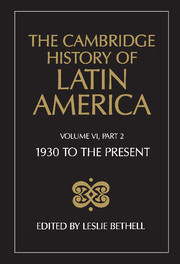Book contents
6 - Rural mobilizations in Latin America since c. 1920
from Part Three - Society and politics
Published online by Cambridge University Press: 28 March 2008
Summary
INTRODUCTION
Political mobilization and social violence have been recurrent phenomena in rural Latin America in the twentieth century. The enormous diversity in these phenomena represents a major challenge for anyone attempting to analyse them from a single perspective or with the purpose of drawing generalizations. However, it is possible to find a common framework for analysis if we accept that for all its heterogeneity rural unrest has taken place in the context of several great, inter-related processes of societal transformation, an essential ingredient of which has been conflict among contending social actors.
First, the hacienda (or latifundio) system and the peasant community ceased to be the dominant organizing forms of agricultural production. The hacienda owners — in so far as they survived as a class — largely lost their political hegemony. At the local level, this meant that they lost much of their capacity to exert social and political pressure (‘extra-economic coercion’) over peasants and workers. The persisting peasantries were no longer ‘tied to the land’. They gained in influence because of their alliances with the new political elites; but their importance steadily decreased vis-à-vis that of the emerging middle classes and the urban and rural proletariat.
Second, the capitalization of agriculture, which was a result of the increasing integration of the countryside with large urban markets and international channels of distribution, took a wide variety of forms, resulting in the emergence of new types of large and medium-sized farms and ranches but also in the transformation of the traditional family (peasant) unit.
- Type
- Chapter
- Information
- The Cambridge History of Latin America , pp. 379 - 482Publisher: Cambridge University PressPrint publication year: 1995
References
- 2
- Cited by

